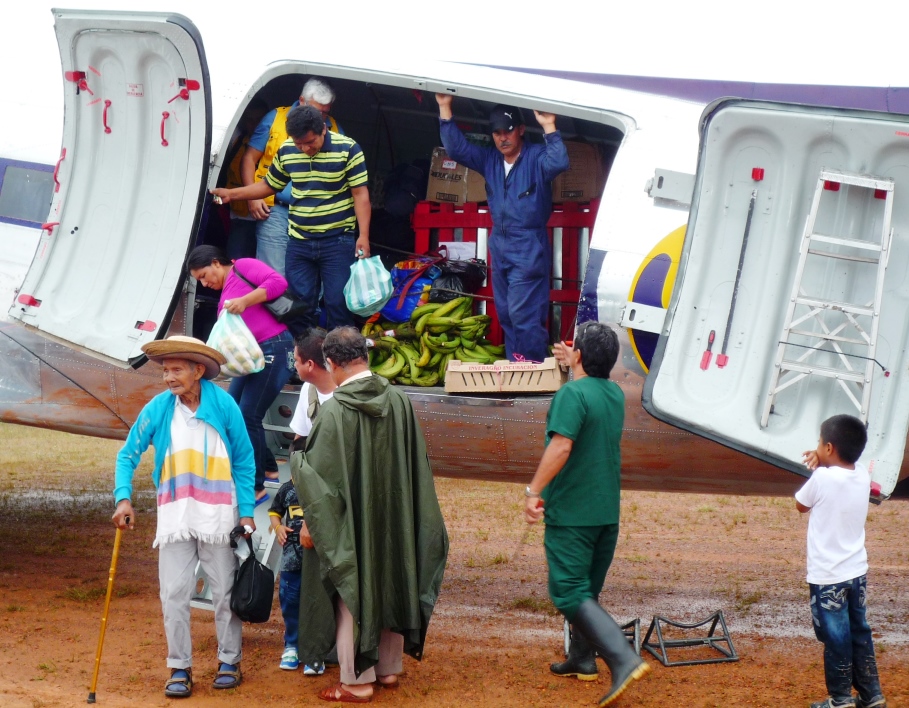DC-3 plane crash in Colombia

A DC-3 crash in Colombia with numerous fatalities throws in doubt the future of these classic planes.
Posted March, 2019. It was also published in The Bogotá Post.
Since this post I have flown in the Colombian Amazon on DC-3s, see a report of this journey here
Colombia’s Amazon: La Pedrera.
For an update on Colombian DC-3s and how to fly them here, see my new post
Flying Colombia’s DC-3s
Has time run out for DC-3s in Colombia?
My first flight in a Douglas DC-3 was in the ‘bucket seat’, which turned to be an actual upturned bucket. It was in fact the pilot’s fishing bucket, as he fully intended to catch pavón – peacock bass – in some tropical river close to our destination. There were no spare seats in the cockpit and the cargo area full. So, the bucket it was.
But what a seat: perched behind the captain and co-pilot, I had a grandstand view of the vast Amazon jungle and oily black Rio Negro as we skimmed over endless trees to a surprisingly smooth landing on a muddy strip.

This particular plane was built in 1943 and had seen action in Europe, the US and Canada before heading south to join Colombia’s DC-3 fleet in the 1970s. The fact that it was still making daily runs around the eastern plains was remarkable for such a venerable work of engineering, especially one defying the laws of gravity. I doubt I would ride in a car or bus built seven decades before.

Would Colombia’s aviation workhorses ever retire? I asked the pilot. ‘Not as long as we can keep holding them together,’ he said.
But now their time is up. Last week’s tragic Aero Laser crash of a DC-3 in Meta, with 14 passengers and crew killed, will surely put these old birds to bed.
For local pilots and aviation-lovers, the Colombia DC-3 crash could spell the end of an era. For their remarkable durability, flyability, reliability and just sheer fun, the DC-3s hold a unique place in flying history. These robust twin-engine mini-airliners first rolled down the runway in 1935. In the following 15 years, more than 16,000 were built in a variety of civilian and military guises and spread to all corners of the globe. And somehow kept on going.
In 2018 an estimated 600 (no-one knows for sure) were still flying worldwide, many in air shows and for joy rides.
Was it ever safe?
In Colombia DC-3s are flying with commercial airlines, mostly based in Villavicencio’s Vanguardia Airport, that provide an essential lifeline of passenger and cargo services to remote communities. From what I could see, there was often no schedule, rather you turned up, got a ticket, then hoped the plane will be repaired ‘some time soon’.
But the eventual journey was worth it with the throbbing radial Pratt and Whitney engines, the original 1930s instrument panels, and a grizzled mechanic wandering around with an oil can. It pitched you back to an era when flying was fun.

It’s hard to get stats on the number of DC-3s operating in Colombia, though five ago there were around 30, according to Al Jazeera. But we do have data on crashes. A Wikipedia list based on official accident reports records 60 incidents globally in the last two decades, of which a third were in Colombia. Of these, eight had fatalities totalling 42 deaths, including last week’s losses on a flight from San José de Guaviare to Villavicencio.
The stats are hard to interpret without wider context. How many DC-3s actually flew? And how often? But we can guess the Colombian-based planes were working longer and harder than elsewhere. And given the terrain here – mountain foothills, tracts of jungle with tropical weather and landing on muddy dirt strips – it’s perhaps a miracle there were not more accidents.

And the fact that many planes were badly pranged – ‘destroyed by fire’, ‘crashed into a tree’ or ‘landed in a rice field’ – but frequently ‘all on board survived’ suggests they had a charmed life.
The crash stats do reveal one worrying trend: in the aftermath ‘substantially damaged’ Colombian DC-3s were ‘put back into service’. So not only were you flying around in a plane fabricated before your grandfather was born, it was also a crash repair.
And not easy to repair. Spare parts for such old planes were scarce, according to a 2015 documentary on Al Jazeera, ‘The Daredevil Pilots of Colombia’, and mechanical problems played a big part in frequent downtime of the DC-3s in Villavicencio. Engine failure was being given as the ‘probable cause’ of last week’s fatal DC-3 crash and burn near San Carlos de Guaroa in Meta.
What happens now? It’s likely the DC-3s will disappear from Colombia’s skies and be replaced by newer planes, such as Antonovs already plying some jungle routes (though the 1970s Soviet cargo planes are hardly spring chickens either).
When they do go, we’ll miss the old DC-3s. The Colombia DC-3 crash is bad news. I’m no plane buff, but I always admired these relics and their place in history. You could say they were on my bucket list. Though I never expected to experience them in Colombia, sitting on a bucket.
- For more information see Al Jazeera’s documentary ‘Risking it All – The Daredevil Pilots of Colombia’.

02:07
Hi! I am trying to find more info about getting a flight in a DC-3. I’ll be there in Novemeber and would love a go! Do you know if tourists can still do trips??
07:19
Hi Helen I posted an update on the site with some info on how to fly on DC-3s in Colombia. In theory it should be easy to do, if you have time on your hands and some patience, and don’t mind travelling around the jungle areas and eastern plains. See my post here: http://colombiacorners.com/flying-colombias-dc-3s/